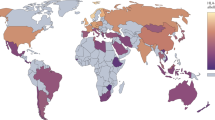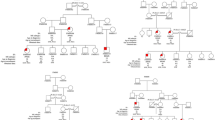Abstract
Multiple sclerosis (MS) is a chronic immune-mediated demyelinating disease of the central nervous system. Evidence from family studies indicates a strong genetic component. Despite many studies of candidate genes, only an association with the HLA-DRB1*1501-DQB1*0602 haplotype has been generally detected, and HLA linkage established by transmission disequilibrium testing. A genome-wide scan revealed suggestive linkage of MS with markers on chromosome 7p15 in HLA-DR15-nonsharing British families, in a region syntenic to a locus predisposing to experimental autoimmune encephalomyelitis in the rat. We therefore tested the 7p15 region as a candidate region for genetic susceptibility to MS in 104 French families with at least two affected siblings. We found evidence suggestive of a predisposing locus in families in which only one affected sibling or none of them carry the HLA-DR15 allele. Comparison of the results of the British and French groups suggests that the region of interest can be narrowed to a 2.45-cM interval.
This is a preview of subscription content, access via your institution
Access options
Subscribe to this journal
Receive 6 digital issues and online access to articles
$119.00 per year
only $19.83 per issue
Buy this article
- Purchase on Springer Link
- Instant access to full article PDF
Prices may be subject to local taxes which are calculated during checkout
Similar content being viewed by others
References
Sawcer S, Goodfellow PN, Compston A . The genetic analysis of multiple sclerosis. Trends Genet 1997; 13: 234–239.
Olerup O, Hillert J . HLA class II-associated genetic susceptibility in multiple sclerosis: a critical evaluation. Tissue Antigens 1991; 38: 1–15.
Yaouanq J, Semana G, Eichenbaum S et al. Evidence for linkage disequilibrium between HLA-DRB1 gene and multiple sclerosis. The French Research Group on Genetic Susceptibility to MS. Science 1997; 276: 664–665.
Swanborg RH . Experimental autoimmune encephalomyelitis in rodents as a model for human demyelinating disease. Clin Immunol Immunopathol 1995; 77: 4–13.
Kuokkanen S, Sundvall M, Terwilliger JD et al. A putative vulnerability locus to multiple sclerosis maps to 5p14–p12 in a region syntenic to the murine locus Eae2. Nat Genet 1996; 13: 477–480.
Roth MP, Viratelle C, Dolbois L et al. A genome-wide search identifies two susceptibility loci for experimental autoimmune encephalomyelitis on rat chromosomes 4 and 10. J Immunol 1999; 162: 1917–1922.
Sawcer S, Jones HB, Feakes R et al. A genome screen in multiple sclerosis reveals susceptibility loci on chromosome 6p21 and 17q22. Nat Genet 1996; 13: 464–468.
Chataway J, Feakes R, Coraddu F et al. The genetics of multiple sclerosis: principles, background and updated results of the United Kingdom systematic genome screen. Brain 1998; 121: 1869–1887.
Goodkin DE, Doolittle TH, Hauser SS et al. Diagnostic criteria for multiple sclerosis research involving multiply affected families. Arch Neurol 1991; 48: 805–807.
Roth MP, Dolbois L, Borot N et al. Three highly polymorphic microsatellites at the human myelin oligodendrocyte glycoprotein locus, 100 kb telomeric to HLA-F. Characterization and relation to HLA haplotypes. Hum Immunol 1995; 43: 276–282.
Abecasis GR, Cherny SS, Cookson WO, Cardon LR . Merlin—rapid analysis of dense genetic maps using sparse gene flow trees. Nat Genet 2002; 30: 97–101.
Lander E, Kruglyak L . Genetic dissection of complex traits: guidelines for interpreting and reporting linkage results. Nat Genet 1995; 11: 241–247.
Xu C, Dai Y, Fredrikson S, Hillert J . Association and linkage analysis of candidate chromosomal regions in multiple sclerosis: indication of disease genes in 12q23 and 7ptr–15. Eur J Hum Genet 1999; 7: 110–116.
D'Alfonso S, Nistico L, Zavattari P et al. Linkage analysis of multiple sclerosis with candidate region markers in Sardinian and Continental Italian families. Eur J Hum Genet 1999; 7: 377–385.
Martin ER, Monks SA, Warren LL, Kaplan NL . A test for linkage and association in general pedigrees: the pedigree disequilibrium test. Am J Hum Genet 2000; 67: 146–154.
Martin ER, Bass MP, Kaplan NL . Correcting for a potential bias in the pedigree disequilibrium test. Am J Hum Genet 2001; 68: 1065–1067.
Martin ER, Bass MP, Hauser ER . A genotype-based association test for general pedigrees: the geno-PDT. Am J Hum Genet 2002; 71 (Suppl): 573 (Abstr. 2365).
Hugot JP, Chamaillard M, Zouali H et al. Association of NOD2 leucine-rich repeat variants with susceptibility to Crohn's disease. Nature 2001; 411: 599–603.
Eugster HP, Frei K, Kopf M, Lassmann H, Fontana A . IL-6-deficient mice resist myelin oligodendrocyte glycoprotein-induced autoimmune encephalomyelitis. Eur J Immunol 1998; 28: 2178–2187.
Gijbels K, Brocke S, Abrams JS, Steinman L . Administration of neutralizing antibodies to interleukin-6 (IL-6) reduces experimental autoimmune encephalomyelitis and is associated with elevated levels of IL-6 bioactivity in central nervous system and circulation. Mol Med 1995; 1: 795–805.
Padberg F, Feneberg W, Schmidt S et al. CSF and serum levels of soluble interleukin-6 receptors (sIL-6R and sgp130), but not of interleukin-6 are altered in multiple sclerosis. J Neuroimmunol 1999; 99: 218–223.
Navikas V, Matusevicius D, Soderstrom M et al. Increased interleukin-6 mRNA expression in blood and cerebrospinal fluid mononuclear cells in multiple sclerosis. J Neuroimmunol 1996; 64: 63–69.
Bedoui S, Miyake S, Lin Y et al. Neuropeptide Y (NPY) suppresses experimental autoimmune encephalomyelitis: NPY(1) receptor-specific inhibition of autoreactive Th1 responses in vivo. J Immunol 2003; 171: 3451–3458.
Maeda K, Yasuda M, Kaneda H, Maeda S, Yamadori A . Cerebrospinal fluid (CSF) neuropeptide Y- and somatostatin-like immunoreactivities in man. Neuropeptides 1994; 27: 323–332.
Kong A, Cox NJ . Allele-sharing models: LOD scores and accurate linkage tests. Am J Hum Genet 1997; 61: 1179–1188.
Acknowledgements
We thank the patients and their families, without whom this study would not have been possible. This work was supported by grants from ARSEP, LFSEP, AFM, and FRM (Programme Action Recherche Santé 2000).
Author information
Authors and Affiliations
Consortia
Corresponding author
Rights and permissions
About this article
Cite this article
Coppin, H., Ribouchon, MT., Fontaine, B. et al. A vulnerability locus to multiple sclerosis maps to 7p15 in a region syntenic to an EAE locus in the rat. Genes Immun 5, 72–75 (2004). https://doi.org/10.1038/sj.gene.6364038
Received:
Revised:
Accepted:
Published:
Issue Date:
DOI: https://doi.org/10.1038/sj.gene.6364038
Keywords
This article is cited by
-
Antineural antibody in patients with Tourette’s syndrome and their family members
Journal of Biomedical Science (2006)



